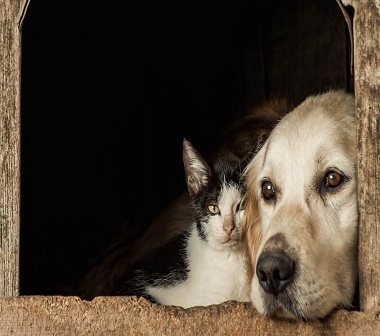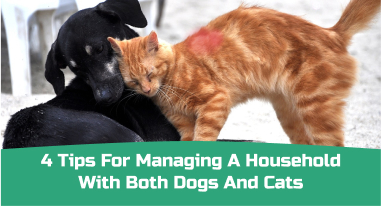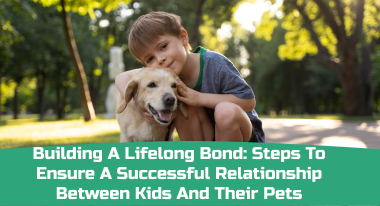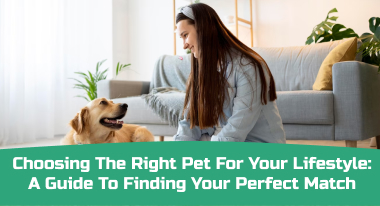Parenting a pet could be one of the most joyous experiences of our lives. Our furry and cute friends – whether a dog, cat, or any other pet animal – deserve to be significant parts of our families. Interestingly, they share their emotions with us through some gestures. We know that pets bring a lot of positive influences to our lives.
At the same time, some situations with our pets may be challenging as well. Usually, being pet parents, we must be conscious of our pets’ health. Providing them healthy food, and an overall healthy environment is our duty. Pets are our close companions, and we must take care of them throughout the ups and downs in their lives.
As an initiative to understand pet parents better and connect them with the pro veterinarians in their areas, we are conducting interviews with pet owners across the country.
Mr. Joseph Williams is an architect and owns a labrador and a cat for about 7 years. Here is an extract of his interview with our team member, Natasha. We hope his answers would help you to understand health or behavioral issues among pets better, and the best ways to find solutions too.
A) PET QUESTIONS
1. How did your pet(s) become part of your family?
Well, the story began through the suggestion of one of my relatives to attend an event in the neighboring town. A pet rescue organization was hosting an event to promote pet adoption. Frankly, my wife and I were not the kinds of ‘intense pet lovers’ before that event.
We attended the event and were emotionally moved to listen to the stories of pet owners relocating leaving their pets behind, street cats searching for food, and some birds rescued through accidental injuries. Again, while passing through the rescue center, we found a labrador puppy and a kitten. Both of them were too cute. My wife decided to adopt these two pets.
After completing the formalities, we were allowed to take them home. The veterinarians at the pet rescue center shared a few care tips and valuable advice. This was seven years ago, and now both of them are our family members.
2. How many pets do you have, and what are their names?
As I mentioned while answering the previous question, we have two pets, a labrador and a domestic shorthair cat. We call the labrador ‘Duke’ and the cat ‘Bella.’ We named them while traveling back home from the event where we adopted them. My wife Sophia gave both these names.
3. Do your pets get along with each other?
It was challenging for us to let Duke and Bella develop a bond with each other at least in the beginning. Both were quite young, yet a dog and a cat happen to be natural enemies. It took us a few months to help them become friends with each other.

Well, we used to supervise every moment of their interaction. Again, we took some time to train Duke to respond to our common voice commands. We created a safe zone for Bella first. Again, we planned their first one-on-one meeting very carefully, when they were young. Later, Duke realized that chasing Bella is not acceptable behavior. Now, their play-time together is interesting and quite fun-filled to watch.
Developing an emotional bond between a pet Labrador and a cat is a process. We, as pet owners, need to be patient and alert while doing that. However, we realized that a dog and a cat can become best friends when trained properly and given sufficient time.
4. What does a typical day with your pets look like?
Duke’s Routine:
Usually, spending time in the morning with Duke is my favorite activity. He gets up by about 7 a.m. I interact with him for about half an hour to take him for a walk across the street. I like petting him and interacting with him for at least 15 minutes.
Furthermore, I clean his bowl and fill it with fresh water. By about 8 AM, when we have breakfast at home, I provide some dog food recommended by our local vet to Duke.
Then, Duke takes another round outside our compound along with my wife and kids for another half an hour. Till 12 in the noon Duke follows my wife when she would be busy in her household chaos. If not, he enjoys a nap going to his cage.
He enjoys going out again for an hour or so. My wife and some visiting neighbors interact with him during this hour. He again goes for a nap till 5 in the evening.
During the next phase of the day, we again clean his bowl and change the water to let him drink. Duke has his dinner by around 7 PM. After that, he enjoys his playtime, watching some TV series along with my wife and kids.
Usually, after our dinner, we prefer going out for some time taking Duke along. Thus, he gets enough opportunities to roam around, mingle with family and neighbors, play, and exercise almost every day.
Bella’s Routine:
My wife Sophia likes spending quality time with Bella in the morning. Bella wakes up and loves to have some fresh clean water from her bowl. Sophia usually keeps the windows open so that Bella should enjoy the environment and some stimulating sounds from outside the home in the morning.
Bella likes to eat several times a day. Sophia makes sure that she eats snacks, food, and treats recommended by our veterinarian, to avoid any health issues due to that. Bella loves to remain within the home almost all the time. She keeps following Sophia, playing mischievous games with Duke, and enjoys playing with toys almost till 1 in the afternoon.
From 1 PM to almost 5 PM, she keeps following Sophia and my kids to make them play with her, grabbing their attention to the fullest. By around 6 in the evening, Sophia serves her dinner. Bella keeps playing till late at night. She prefers a clean and tidy litter box.
Again, she is a bit choosy about her food. Being a cat, she hunts for smaller creatures within our compound sometimes. I feel it is natural. Yet, she enjoys the company of all the family members. We love interacting with her and making out the meaning of every new kind of ‘meow’ she utters.
5. What do you feed your pets?
As Duke is a Labrador weighing close to 70 pounds (32 kg approx.), we feed him about 3.5 cups of daily food. Yet, as he enjoys diversity in solid and wet food, we see to it that he gets it every day. He loves some packaged dog food varieties like Royal Canin Maxi and chopped chicken and rice from Pedigree.
For Bella’s age, weight and stage, we prefer providing her with sufficient animal-based protein as our vet recommended. We provide her with grain-free cat food, optimum in protein. She also likes snacks and milk.
6. What are your pet’s favorite treats?
Both Duke and Bella enjoy some shorties treats made of fish and some meat treats made by dehydrating chicken, lamb, and pork meat and grilled. We prefer locally-made treats as we get them fresh.
Duke loves chewable dental bones (made of starch, flour, glycerin, and other ingredients) as a treat. Sometimes he enjoys some sticks, chewies, and nuggets. My wife prepares some recipes at home and some of them we buy from the stores. Bella loves bonito flakes as snacks.
7. What is your one favorite thing about your pets?
Duke is very sharp and has an appreciable grasping power. Whenever we try to train him with some voice commands, he understands them quickly and implements them from the very next instance. I admire his obedience and loyalty the most.
Bella is a hyper-active, cute, and very expressive pet cat I have ever seen. I like her expressive body language. She conveys her feelings effectively through her eyes, ears, body posture, and tail. It is enjoyable to watch her playing with toys and interact with her from time to time.
B) VET QUESTIONS
8. If your pet gets hurt, what do you do? Do you contact your vet immediately or first try to address the injury yourself?
Honestly speaking, our local vet explained once about the best possible first-aid for pets. We ordered some items online and prepared a first-aid kit for our pets. We try to avoid any accidents and injuries to our pets through constant supervision. If something goes wrong, my wife and I try to analyze the severity of the injury. We provide first-aid as per our knowledge, to begin with.
Even if the injury is normal, we prefer to contact our local vet to explain the incidence and the kind of injury the pet has. If required, we take Duke or Bella to the veterinarian for further diagnosis and treatment.
9. Do you have a dedicated vet? If so, why did you choose this particular one?
We often take our pets to a locally available veterinarian, Dr. Smith, for routine checkups, vaccinations, and other medical requirements. There are only a few licensed veterinarians in our hometown. One of my neighbors suggested this veterinarian maybe 6 years ago.
Fortunately, the vet, Dr. Smith has a well-equipped clinic here and he is well-versed in diagnosis and treatment for many basic to advanced health issues among pet dogs and cats.
10. Does your primary veterinarian cater to all your specific needs and medical specialties?
Our local veterinarian, Dr. Smith handles various health issues carefully. However, his clinic and his overall experience have some constraints when it comes to specialty treatments. So, we need to search for specialty hospitals for Duke and Bella, in case any advanced treatment would be required. The need hasn’t arisen so far and I hope that Dr. Smith would recommend a specialist in case if he doesn’t have the necessary infrastructure for advanced treatment.
11. Do you have a ‘backup vet’ in case your primary one is not available?
Unfortunately not at present. We developed a healthy relationship with Dr. Smith through the last few years. Frankly, there were the least emergencies to attend so far for both Duke and Bella. So, we did not think of this option of finding a ‘backup vet.’
However, I understand that it is always better to have a plan B. Finding another vet would help us in case of emergencies, and also have a second opinion.
12. Have you changed vets and, if so, can you tell us the reason why?
So far, we did not require changing vets as we were quite satisfied with the way Dr. Smith, our local vet diagnoses and treats our pets. In case of Dr. Smith would be unavailable, or perhaps when any advanced treatment would be required for my pets, I need to find some specialist.
13. Do you have a regularly scheduled check-up/care routine? Or do you schedule appointments on an as-needed basis?
Yes. We do follow a preventive care routine for both Duke and Bella. Usually, I call Dr. Smith, our local veterinarian, to check Duke and Bella on the second Friday of every month.
Again, in case of any special requirements due to any injury or illness, I fix an appointment with Dr. Smith and take the respective pet or both to his clinic in my hometown.
14. How do you schedule your appointments? A phone call, online, other?
To schedule an appointment with Dr. Smith, our local and usual veterinarian, I prefer calling either on his number or the contact number of his clinic.
However, I have not tried any other methods to book an appointment with a specialist veterinarian or animal behaviorist so far. I hope it would be possible to book an appointment online through the platform that my sister had suggested, greatvet.com.
15. If you could improve something about scheduling appointments with your vet, what would it be?
I feel there is no harm in calling the veterinarian for a routine checkup or vaccination. However, emergencies are uncertain. So, I need to adopt a mechanism to reach the specialist veterinarian round the clock to cater to emergencies.
Sometimes, I feel awkward calling the vet late at night. That makes us wait till the next morning and it is painful to see pets going through any sort of health issue.
16. If you could improve something about your primary vet clinic itself, what would it be?
As my hometown is not a metropolitan city, I feel that Dr. Smith, our local veterinarian should collaborate with some specialists. It would be better if Dr. Smith could arrange to have a specialist here once a week. My pets, Duke and Bella would have better access to advanced healthcare through the specialist’s expert advice.
17. Can you share a story of how your veterinarian went above and beyond to care for you and your pet(s)?
Maybe four years ago, we noticed some unusual symptoms with Duke. He had a fever, and he was vomiting sporadically for a day. Also, we felt that he was not as active as he is usually.
I called my local veterinarian Dr. Smith and explained the situation. As he asked me to take Duke to his clinic, we took Duke there within the next half an hour. Dr. Smith examined Duke and asked some questions about his routine and behavior.
Dr. Smith diagnosed Duke with Canon Parvovirus. He explained that it is due to a virus that spreads through the fecal matter of sick dogs. I was not sure if Duke having been exposed to feces while taking a walk outside our premises. Also, I was worried as I wasn’t aware of this disease before.
Dr. Smith appreciated me notice minute changes in Duke’s behavior and contact him immediately. He further added that the infection might be in its initial phase. So, Duke needed immediate treatment before the virus could attack his internal organs.
Dr. Smith told me that some of the symptoms of this viral infection may be fever, lethargy, dehydration, vomiting, and in some cases, diarrhea. He said it is challenging to kill this virus once it reaches the significant internal organs of any dog.
He asked me to keep Duke under his observation for the next 1-2 days. He administered some vaccines to avoid secondary infection. Not only that, but he also asked the staff to feed Duke with some kinds of fluids consistently.
Unfortunately, Duke was not vaccinated for Canon Parvovirus before. Further, Dr. Smith asked the nursing staff to administer electrolytes at regular intervals. I was in tears as Duke seemed drowsy and lazy as I brought him to the clinic.
Dr. Smith assured me that treatment has started at the right time. Duke would be alright within a few days. He said that usually, Canon Parvovirus can be fatal if not treated at the right stage.
I was happy about the precise diagnostic abilities and deep understanding of various diseases Dr. Smith has.
The vet used to constantly observe Duke’s condition, check various parameters, and recorded every detail. He had already developed a bond with Duke. He used to visit our home, or we used to take Duke to him regularly.
Dr. Smith ensured that the condition should not deteriorate and Duke would have a speedy recovery. Duke was in the hospital for two days, and when his condition started improving, he was discharged and allowed to go home.
Yet, while discharging Duke, Dr. Smith had an in detailed discussion with me to explain Dos and Don’ts, precautions we need to take, further medication, and the expected changes in Duke’s routine. We followed all his instructions and took Duke to his clinic twice a week for a checkup.
It took Duke a few weeks to recover and get back to his routine. I am grateful to Dr. Smith for his timely analysis and the correct treatment he rendered to save Duke. That incident made my family more cautious about hygiene, supervision of pets and seeking immediate expert advice when something is unusual.




